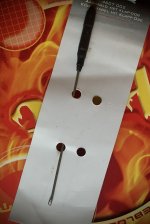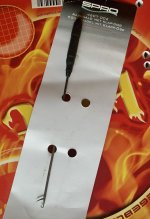Use the ‘wack it’ technique.
Get get the through hole hot and the solder melted, then quickly wack the edge of the PCB firmly on the table - the solder shoots out the hole. Job done. I got this trick off a YouTube video.
(When you wack it, the PCB must be oriented on the same plane as the table so not edge on)
Get get the through hole hot and the solder melted, then quickly wack the edge of the PCB firmly on the table - the solder shoots out the hole. Job done. I got this trick off a YouTube video.
(When you wack it, the PCB must be oriented on the same plane as the table so not edge on)
When I remove multileggers, I use a solder sucker to pull as much solder from the hole as possible. Then I use needle nose pliers to rock the lead back and forth to break any solder between the corners of the lead and the plated through hole. Typically it would free the lead, and I go on the the next one. Once all the leads are loose, the multilegger simply comes out.
John
John
Pass DIY Addict
Joined 2000
Paid Member
I just spent some time recapping the board in my CD player. I replaced 40 electrolytic caps and found that solder braid did exactly what I needed it to. Just lay the braid on the solder blobs on the back of the board, press down with a hot iron (380-400c), and the holes came nice and clean in just a few seconds. The caps literally just fell right out of the pcb. In one or two cases, one leg still had a bit of solder on it. Touching the iron to the leg flowed what little bit of solder was left over and it came out very easily. Three legged critters might require a little more fiddling, but it was an easy process for me.
today i had trouble removing the solder from a pcb (not the first time)simpler method that pulls all the solder out of the hole.
the hole is small, 0.8mm
in the end, i tried heating up one side of the pad and used a solder sucker from the other side.
this gave me about 70% success (to clean out the hole) on the first go.
Pass DIY Addict
Joined 2000
Paid Member
Another thing that sometimes works well for me is to get the hole good and warm, then hold the board up to your mouth and blow forcefully. Of course, this sprays solder out the other side of the board, so you want to make sure you don't have anything in your work area that you don't want damaged by a hot blob of solder. I find this faster than trying to fiddle with a solder sucker, depending on the situation. Another trick is to slide a single strand of solid core wire through the hole along with your iron to pick up the remaining bits of solder. Strands from CAT5 wire sometimes work well for this task.
For multileggers, I sometimes resort to pushing the leg away from the side repeatedly with a decreasing "duty cycle" until the leg cools enough not to stick.
This technique was refined changing out chips on a hundred or so 4-layer boards. This was necessary because these were actually Dallas SmartSockets (with built-in lithium cells), so clipping off the pins and pulling them individually wasn't possible. I won't say anything about using smart sockets with a 10 year service life on equipment that's expected to last 40 years. Or how some of those sockets had already been replaced twice due to damage during assembly (don't get batteries wet!) and Dallas making a revision that made them susceptible to EMI if you connected the data and address pins to data and address lines.
This technique was refined changing out chips on a hundred or so 4-layer boards. This was necessary because these were actually Dallas SmartSockets (with built-in lithium cells), so clipping off the pins and pulling them individually wasn't possible. I won't say anything about using smart sockets with a 10 year service life on equipment that's expected to last 40 years. Or how some of those sockets had already been replaced twice due to damage during assembly (don't get batteries wet!) and Dallas making a revision that made them susceptible to EMI if you connected the data and address pins to data and address lines.
I use a solder sucker but have a short length of silicon tubing over the end to seal the air in.
I read your post earlier and think it makes sense. I also have a desoldering pump and will try it with a piece of silicone hose.
- Home
- Design & Build
- Construction Tips
- Having trouble completely removing solder from through-hole joints

